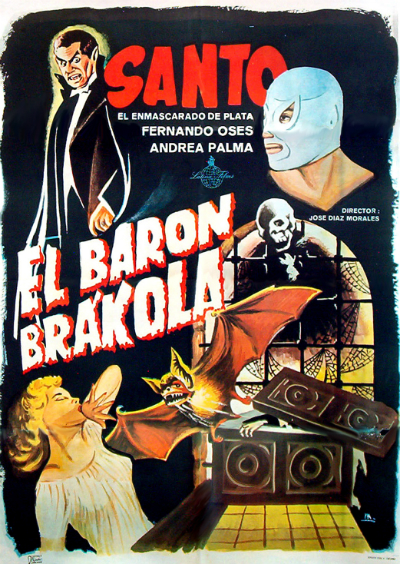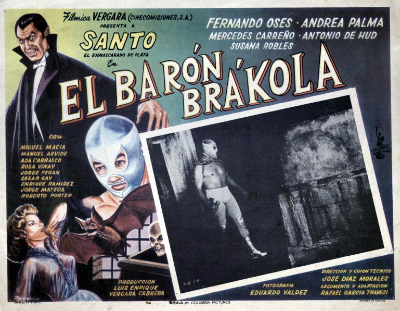El Barón Brákola
(Filmica
Vergara-Cinecomisiones, 1965)

Prod: Luis Enrique Vergara C.;
Dir/Scr: José Díaz Morales; Story: Rafael García
Travesí , Fernando Osés; Photo: Eduardo Valdez; Music: Jorge
Pérez Herrera; Prod Mgr: Roy Fletcher; Prod Chief: José
Rodríguez R.; Asst Dir: Angel Rodríguez; Film Ed:
José Juan Munguía; Camera Op: Dagobied Rodríguez;
Makeup: Armando Islas; Dialog Rec: Jesús Sánchez;
Music/Re-rec: Salvador Topete; Fencing: Jorge Mateos, Julio Porter; Union:
STIC
CAST: Santo (himself), Fernando Osés (Barón
Brákola), Mercedes Carreño (Silvia), Antonio de Hud
(Eduardo), Andrea Palma (Rebeca's mother), Ada Carrasco (Aurora), Susana
Robles (Rebeca), Miguel Macía (don Fernando), Manuel Arvide (don
Luis); Rosa Vinay (barmaid?), Jorge Fegan (servant), César Gay,
Enrique Ramírez, Jorge Mateos, Roberto Porter; WRESTLERS:
Quasimodo, Benny Galán, Juan Garza; Margarito Luna (spectator),
"Picoro" (ring announcer)
Mexico City release: January 1967; 1 week run; Authorization: A
Spanish release data: Authorization date: 5 June 1967; Total
spectators: 231, 474
This film played theatrically in Texas, California, and Arizona from the late Sixties into the early 1970s.
Locations included Victoria, TX (May 1967, August 1968), Phoeniz, Az (July and Oct 1971, April and October 1972),
Tucson, AZ (Oct 1972, May 1973), Los Angeles, CA (March and August 1973), Fresno, CA (May and September 1971).
NOTES: An interesting entry in the Santo filmography. With Fernando
Osés as the chief villain (instead of just a henchman, as usual),
this film contains some of the most boneshaking, brutal fights of any
Santo picture--Santo and Osés
mix it up numerous times, and both men go at it with a vengeance.
Otherwise, the picture isn't too bad, the cheesy production values
actually serving to enhance the bizarre atmosphere.
There are a couple of points worth noting. First, a significant
portion of the film is set in 1765, with Santo's "ancestor," the
"Caballero Enmascarado de Plata" as the hero. Dressed in a frilly
colonial costume, this character wears two different
masks: one a fairly plain, 3/4 face mask tied with a string (exposing
only his mouth and chin), the other a glittery silver domino mask,
exposing a large portion of the performer's face. Neither mask is the
typical, full-head Santo mask. It's doubtful this is actually Santo
(Rodolfo Guzmán Huerta), except perhaps in the action scenes, since
the hair and face that can be seen do not seem to belong to a man of more
than 50 years of age. Furthermore, this character engages in several
sword fights, so it is possible the man behind this particular silver mask
was one of the credited fencing masters. As usual, Santo--and the
Caballero--has his dialogue dubbed, so it would not have been necessary to
hire an experienced actor for the role.
Another role which seems to have undergone a casting change was that
of "Silvia." Emilio García Riera reports that Ana Martín
quit the film and filed a grievance with ANDA (the actors' union),
complaining that the producer was using Meche Carreño as a nude
"body double" for her. Apparently, Carreño was then assigned the
acting scenes as well (she had appeared in bit roles in a few pictures
prior to this but was not a well-known actress). No nude scenes appear in
the Mexican version of this picture.
Baron Brákola emerges from his coffin, in a hidden chamber in
the musty dungeon (filled with mummies, stuffed animals, masks, rats, and
cobwebs) of an old house. He goes into another chamber where a coffin
contains a pile of rags and a wooden
stake: these are the remains of his long-lost love, Rebeca, who was
killed in 1765 by an ancestor of Santo. Brákola swears vengeance
on all who participated in this.
Meanwhile, Santo is participating in a match. Eduardo and Silvia are
among his fans. Afterwards, in the deserted arena, middle-aged don Luis
is attacked by the Baron. Santo comes to his assistance. "Stick a stake
in his heart!" don Luis shouts, "The stake! The stake!" When Santo
finally gets the hint and picks up a nearby stake, Brákola screams
and disappears. Back at don Luis's house, the older man tells Santo that
he moved to Mexico from Europe, where he and his daughter Silvia lived "
in a region famous for its legends of monsters and vampires." Santo says
"I've had experience with that class of beings." Don Luis says he doesn't
live with his daughter Silvia because he is a descendant of the long-dead
Rebeca, and thus a target for Brákola's vengeance. He tells Santo
the story (in flashback):
In colonial Mexico in 1765, the rich Baron Brákola asks don
Fernando and his wife for permission to marry their daughter, Rebeca.
Don Fernando says it's up to her, and Rebeca definitively refuses. The
Baron says they'll pay for treating him like this. Worried about the
threat, don Fernando contacts the Caballero Enmascarado de Plata, who
promises to help protect them. The Baron sends two hired swordsmen to
kill the Caballero, but they fail; the Baron himself (after attacking a
barmaid), joins the fray, and is fatally wounded. He retreats to his
crypt (which already bears a sign "Baron Brákola,
1661-1765").
 He is resurrected as an ugly (very bushy eyebrows, beetling brow,
and a generally moronic look, sort of like Humphrey Bogart with
acromegaly) vampire. He begins a series of nocturnal visits to Rebeca,
drinking her blood. During his final visit (Rebeca dies), the Caballero
bursts in and a long fight ensues. The Baron is ready to finish off his
opponent when Rebeca's spirit appears; they walk off together. Later,
Brákola digs up Rebeca's coffin and carries her corpse back to his
house.
He is resurrected as an ugly (very bushy eyebrows, beetling brow,
and a generally moronic look, sort of like Humphrey Bogart with
acromegaly) vampire. He begins a series of nocturnal visits to Rebeca,
drinking her blood. During his final visit (Rebeca dies), the Caballero
bursts in and a long fight ensues. The Baron is ready to finish off his
opponent when Rebeca's spirit appears; they walk off together. Later,
Brákola digs up Rebeca's coffin and carries her corpse back to his
house.
Rebeca, now a vampire herself, even tries to attack the Caballero
(like Santo, he sleeps in his mask), but is scared off when he tells her
to "believe in God." Campesinos start to turn up dead. Finally, the
Caballero locates Rebeca's coffin and stakes her, but can't penetrate the
Baron's burial chamber. And so the flashback ends, with don Luis telling
Santo that the Baron, after being dormant for years, is now back for
revenge. Santo leaves. Brákola appears and hypnotizes don Luis
into writing down Silvia's address. When don Luis wakes up, he sees the
piece of paper and calls Santo. They arrive too late, Silvia has already
been bitten. However, Santo supervises a blood transfusion from Eduardo
to Silvia. Don Luis gives him a map that allegedly shows the location of
Brákola's hideout.
Brákola takes the place of one of Santo's opponents. A rough
match ensues (the referee is tossed out of the ring!), but Brákola
screams and flees when don Luis shows up and flashes a cross at him.
Santo uses the first map to find a second map (hidden under a mantle
beneath a painting of the Virgin of Guadalupe, where vampires couldn't get
it). He locates Brákola's house. Oddly enough, after more than
200 years it still looks the same, nobody lives there, and even the
furniture is still intact. Locating Brákola's crypt, Santo engages
in yet another long and brutal fight with the vampire, finally ramming a
wooden stake into his supernatural opponent. Brákola manages to
climb back into his coffin before expiring, this time for good.
José Díaz Morales directs El Barón
Brákola competently, although he does have one little odd
habit--cutting to extreme long shots during action scenes. For instance,
during the Baron's attack on don Luis and Santo in the arena, there are
several very long, high angle shots of the ring, as if taken from the
highest seat in the building, so that the actors are tiny little dots!
Similarly, when the Caballero and the Baron are fighting on a second-floor
veranda, there are shots of the building from around 100 feet away!
The cast is generally good. Osés is dubbed and his monster
makeup makes him look stupid, but he's quite bestial and probably the best
opponent Santo ever had, action-wise. Of the others, Antonio de Hud shows
up in only two scenes, a nothing role; Meche Carreño has a little
more footage but doesn't have to do much, the same for Andrea Palma and
Ada Carrasco. Manuel Arvide comes off best of the supporting players,
with a substantial amount of footage.
Production values on the Vergara films--both the Santo and Blue Demon
vehicles in this era--were not high. The black and white photography is
rather harsh and day-for-night shooting is especially bad, giving the
appearance of continuity errors as the image shifts from bright to dark in
alternate scenes. The sets are sparse, and seem to have been furnished
with odds and ends that looked "weird" (a stuffed possum or weasel is
particularly prominent). As in Atacan las brujas, important plot
points are cleared up by being tossed in, after the fact, in dialogue:
here, the Caballero remarks that he "heard" that killing a vampire's mate
would cause a vampire to lie dormant for "some time," the only explanation
given for Brákola's absence from the scene from 1765 to 1965 (it
doesn't explain how, when he wakes up in 1965, he automatically knows who
to go after for revenge). The canned music is only occasionally
appropriate.
However, there is something about the Vergara pictures that is
endearing: their very cheesiness makes them fun to watch, and they aren't
dull.
Back to the
Santo Filmography.
Review by D. Wilt (dwilt@umd.edu). 22 December 1997. UPDATED:
22 FEb 2021
 He is resurrected as an ugly (very bushy eyebrows, beetling brow,
and a generally moronic look, sort of like Humphrey Bogart with
acromegaly) vampire. He begins a series of nocturnal visits to Rebeca,
drinking her blood. During his final visit (Rebeca dies), the Caballero
bursts in and a long fight ensues. The Baron is ready to finish off his
opponent when Rebeca's spirit appears; they walk off together. Later,
Brákola digs up Rebeca's coffin and carries her corpse back to his
house.
He is resurrected as an ugly (very bushy eyebrows, beetling brow,
and a generally moronic look, sort of like Humphrey Bogart with
acromegaly) vampire. He begins a series of nocturnal visits to Rebeca,
drinking her blood. During his final visit (Rebeca dies), the Caballero
bursts in and a long fight ensues. The Baron is ready to finish off his
opponent when Rebeca's spirit appears; they walk off together. Later,
Brákola digs up Rebeca's coffin and carries her corpse back to his
house. 